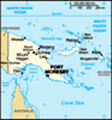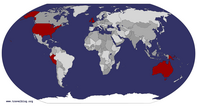Advertisement
Published: January 21st 2018

 Dokta Bill
Dokta Bill
Me with Dr. Bill McCoy - missionary physician extraordinaireFor the past week, I have been rounding on the medical ward with Dr. Bill. On the medical ward, interestingly enough, many of the problems that we manage are very similar to those on a medical ward in the US: COPD exacerbation, congestive heart failure exacerbation, pneumonia, etc. And then there are some cases that I have never seen on a medical ward at home: typhoid, osteomyelitis, malaria.
After rounds end in the morning, usually sometime between 9:00 and 10:00, we head over to the outpatient department (OPD) and start seeing all the outpatients for the day. The way this works is that patients will line up outside the hospital, nurses will screen patients to see who actually needs to see a physician, they then come and wait inside to see the next available doctor, five or so of whom staff the OPD each day. I got to function as one of these doctors. I have my own clinic room and saw a vast variety of patients on my own. I would review their history, perform whatever physical exam was necessary, order and interpret labs and X-rays, and write prescriptions. Obviously, anything I was unsure of I would consult with

 TB
TB
A chest x-ray showing diffuse TB is the left lung and moderate in the right.one real doctors. Being that I’m quite slow, I would see 15 or so patients per day. It’s not unusual for the efficient doctors to see 30+ in a day.
Of all the patients I saw, there were probably only 30% or so who would be classified as “routine patients” by US outpatient standards. On Monday alone I diagnosed an inguinal hernia, hemorrhoids, possible inflammatory bowel disease, possible intracranial tumor, and possible schizophrenia. The reason I have to modify diagnoses with “possible” is because here there are some diagnoses that can’t be confirmed due to lack of resources. For instance, the boy I saw who clinically had many signs of a brain tumor, the only CT scanner is in Port Moresby, an hour plane ride away. There is no way for us to confirm. The possible schizophrenia is a psychiatric diagnosis, but is difficult to confirm because of the limited vocabulary of the language in asking questions. It’s difficult to assess delusions and hallucinations when no such words exist.
Tuesday I saw splenic tuberculosis. Tuberculosis (TB) is one thing that we learn about quite a bit in medical school, but I had never actually seen a patient with
it until I came here. When a person presents to the clinic in the US with a cough or some other symptom, TB is going to be much lower on the list or possible causes than say, pneumonia or an upper respiratory infection. Here, TB is on the list for almost every presenting symptom. Cough? TB. Weight loss? TB. Abdominal swelling and distention? TB. Back pain? TB. Neurological changes? TB. Though this bacterium most often affects the lungs, there is hardly an area of the body where it won’t take up residence. Through the week, I’ve ordered my share of x-rays on suspected TB patients, many of them coming back positive. On Tuesday I also got to relocate a dislocated shoulder, see a case of Henoch-Schonlein Purpura (another one of those rare diseases we learn in medical school, but almost never see), another inguinal hernia, and diagnosed a patient with HIV. HIV is becoming more and more prevalent here. Though there is a clinic through the hospital that tracks and treats nearly 1000 patients with the virus, there is limited available drugs compared to the US.
Wednesday saw more TB, a midline jaw fracture, splinting of a radial fracture,
thoracentesis for a pleural effusion, and three incisional hernias on the same incision on the same patient. An incisional hernia occurs when a patient has an incision for surgery and due to the inherent weakening caused by opening and then sewing shut the fascia (the strength layer of the abdominal wall) a hole appears and bowel or fat can poke through. This patient had three on the same incision. Maybe her previous surgeon should have taken more care in closing her fascia (don’t worry, it was done at another hospital, not by one of the fine surgeons at Nazarene General Hospital).
Thursday saw more pneumonia and TB. My most memorable and most heart wrenching patient of the week was an 11 year old boy named Johannes. As soon as Johannes walked in the room with his mom I could see that something wasn’t quite right. His head was too large for his little body and was misshapen. He had proptosis, where his eyes stuck out of his head. He couldn’t move his head very far up or down, or left or right. When I did a funduscopic exam of his eyes, I saw no margins on his optic discs,
meaning that the pressure inside of his head was significantly increased. This, along with the rest of his history and exam, made a brain tumor jump to the top of the list. I consulted with Dr. Erin Meier and she agreed. We asked the family if they had the means to go to Port Moresby for a CT scan and possible treatment, which they did (most patients in this area would never be able to afford that) and I wrote the referral. Not being able to offer much help other than a dose of steroids to hopefully decrease the swelling in his skull, I was able to pray with Johannes and his mom. That’s one of the things I love most here. I get to pray with so many patients who have diagnoses big and small. It really keep things in the eternal perspective; we may successfully treat many patients and cure many diseases, but if we are not ministering the Gospel to them, then we’re not taking their merely kicking the mortal can down the road. As the motto of this hospital says, “We Treat, Jesus Heals”.
Friday was more TB, a lumbar puncture, casting of a radial

 Vertebral osteomyelitis
Vertebral osteomyelitis
Osteomyelitis is an infection of the bone. Dr. Bill (who has seen literally tens of thousands of patients during his career) states that he's only seen vertebral osteo 1 or 2 other times. fracture, hepatitis, chronic heart failure, umbilical hernia, and diabetes, to name a few. One thing I saw (that I cannot unsee) was a man with a swollen scrotum the size of a large pineapple. I kid you not. We thankfully have the ability to refer to a urologist in the largest city in the Highlands, because there is no way to medically manage that.
That summed up the week in clinic. There is such a joy in taking ownership of one’s own patients. I got to see many treatments through all the way, which is very satisfying. For example, one of my patients had significant arm pain after a fall, so I got an x-ray. Sure enough, her radius was fractured. I consulted with one of the doctors about positioning of the bone and then plastered her cast on and prescribed pain meds and calcium supplements. All within less than an hour. This is the great thing about not having a fixed and rigid patient schedule in the clinic – we can take extra time with the patients that need it.
My other medical experiences for the week included being on call Monday night and all day and

 Wapi
Wapi
Wapiis an elderly native gentleman who sells asparagus and other produce around the station. He carries it all in this sack on his forehead. night Saturday. Monday’s call was the most eventful of my four on-call nights here. The patients I saw included a woman coughing up blood, a man who had been struck by lightning the previous day (he was fine, other than numbness in his legs), and a man with new onset seizures. It was also a procedure heavy night. I was on with Dr. Erin and she is awesome at letting me get my hands on as many cases as I can. I performed an incision and drainage on a tunneling abscess on a boy’s leg, inserted an intraosseous line into a severely dehydrated baby (when the tests came back the next day, it turns out she had meningitis), and performed a dilatation and curettage on a woman with dysfunctional uterine bleeding.
Saturday was a busy morning and early afternoon that included diagnosing and treating typhoid, admitting a 10 month old with pneumonia, and treating a patient who was the victim of domestic violence. Being that the PNG Highlands are an area traditionally (and currently) dominated by men, domestic violence is a sad and all too common occurrence. My patient had been beaten with a stick, kicked in the chest, cut with a bushknife, repeatedly hit in the head with a hammer, had her foot chopped with an axe, and stabbed multiple times with a screwdriver. Amazingly, she had no broken bones or life-threatening trauma. A patient’s story has never left me feeling so sick in my life as this one did. How do humans do things like this to one another? Especially one’s own family?
If you’re a non-medical person and you’re still reading, kudos to you. I’m sure many were either bored, disgusted, or traumatized by my recounting of the week. But on the lighter side: I did go hiking today with my friend John Gari. He lives just across the river beside the mission station and knows the terrain here like the back of his hand. We hiked up and down several mountain ridges that commanded an astounding view of the valley. It’s the type of view where you almost hate to attempt even taking a picture, because any picture will not do justice to the visual memory of standing on a mountain in the sunshine and seeing for dozens of miles in every direction.
Advertisement
Tot: 0.114s; Tpl: 0.012s; cc: 5; qc: 45; dbt: 0.0822s; 1; m:domysql w:travelblog (10.17.0.13); sld: 1;
; mem: 1.1mb










Larry Ferren
non-member comment
Great Report
Brian, I read your reports with rapt attention. You write excellent reports. Keep them coming. L. Ferren